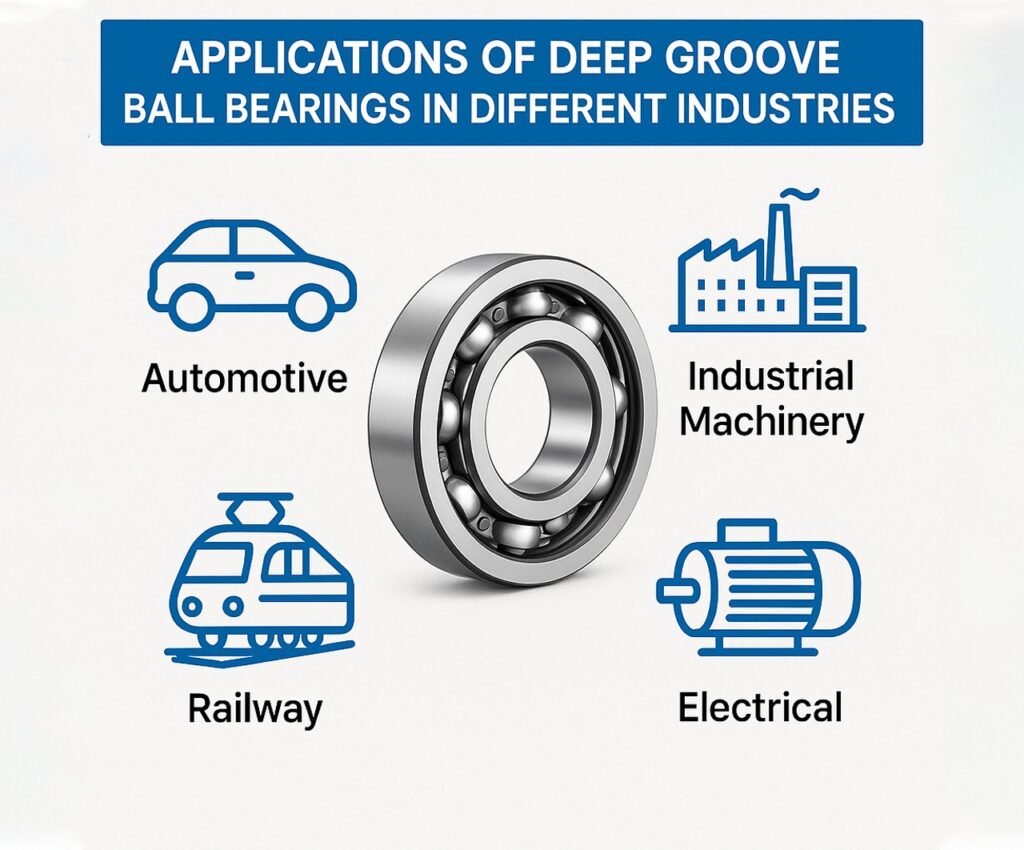When it comes to reliable and versatile components in machinery, deep groove ball bearings top the list. Used across a broad range of industries, these components handle radial and axial loads efficiently. Three terms often searched by engineers and buyers alike are deep groove ball bearing contact angle, single row deep groove ball bearing, and deep groove ball bearing puller. These phrases signal a growing interest not just in the bearings themselves, but in their operational specifics, maintenance tools, and configurations. Know More
What Are Deep Groove Ball Bearings?
Deep groove ball bearings are the most common type of rolling-element bearings. They feature inner and outer rings with deep symmetrical raceways. Their design supports radial loads and moderate axial loads in both directions. With high-speed capability, low friction, and low maintenance requirements, they are a go-to component across various applications.
The deep groove ball bearing contact angle is minimal compared to angular contact bearings, making these ideal where axial load requirements are not dominant. However, certain variations with modified raceway geometry can support more significant axial loads while still operating at high speeds.
Key Features
- Simple design and easy integration
- Low operating friction
- High speed performance
- Wide range of sizes and load ratings
Now let’s look at how different industries deploy single row deep groove ball bearings to improve efficiency, reduce downtime, and ensure long-term reliability.
1. Automotive Industry
In the automotive world, performance, durability, and noise reduction are paramount. Single row deep groove ball bearings are used in everything from alternators to transmissions, wheels, and air conditioning units. Their ability to operate at high speeds with minimal lubrication makes them ideal for these applications.
The deep groove ball bearing contact angle in automotive parts is engineered to balance load distribution. This reduces premature wear and enhances fuel efficiency by reducing friction losses. Maintenance teams often use a deep groove ball bearing puller to ensure safe and damage-free extraction during servicing.
2. Electric Motors and Household Appliances
Electric motors depend heavily on deep groove ball bearings for smooth operation. Small to medium motors, such as those found in vacuum cleaners, washing machines, and HVAC systems, often use single row deep groove ball bearings to handle both radial and axial forces.
Here, the deep groove ball bearing contact angle plays a role in maintaining alignment and reducing vibration. These bearings allow electric motors to operate quietly and with minimal energy loss, a crucial factor in today’s energy-conscious world. For repairs, technicians rely on a deep groove ball bearing puller to replace worn-out units with minimal downtime.
3. Aerospace and Defense
Precision and reliability are non-negotiable in aerospace. Deep groove ball bearings are used in a range of components, from control systems to actuators and gyroscopes. The single row deep groove ball bearing is often the choice for its low weight and consistent performance.
Given the extreme operating conditions, the deep groove ball bearing contact angle is precisely engineered to handle thermal expansion and vibration. Specialized deep groove ball bearing pullers are used during scheduled overhauls to prevent damage to adjacent sensitive components.
4. Agricultural Equipment
Agricultural machinery is exposed to dust, moisture, and heavy loads. Single row deep groove ball bearings are used in tractors, harvesters, and irrigation pumps due to their sealed design and load capacity.
The deep groove ball bearing contact angle ensures proper load distribution even on uneven terrain. With the help of a deep groove ball bearing puller, maintenance crews can quickly service these bearings in the field, minimizing equipment downtime during critical planting or harvesting periods.
5. Manufacturing and Industrial Automation
Modern factories run 24/7, and downtime is costly. Deep groove ball bearings are integral to conveyor systems, robotics, and gearboxes. The single row deep groove ball bearing offers a compact and reliable solution in tight mechanical assemblies.
Engineers often optimize the deep groove ball bearing contact angle for specific torque and load requirements. In maintenance routines, a deep groove ball bearing puller is essential for fast and safe disassembly, which keeps production schedules on track.
6. Medical Equipment
In medical devices, precision and hygiene are critical. Deep groove ball bearings are used in MRI machines, centrifuges, and surgical robots. Their low vibration and noise characteristics are essential in such sensitive equipment.
The single row deep groove ball bearing supports stable performance in compact designs. The deep groove ball bearing contact angle in these applications is calibrated to reduce axial stress, ensuring longevity. For servicing, a deep groove ball bearing puller allows for non-invasive maintenance.
Emerging Applications
As technology advances, new uses for deep groove ball bearings are emerging:
- EVs (Electric Vehicles): Require bearings with specialized deep groove ball bearing contact angle to handle high RPM motors.
- Drones: Use lightweight single row deep groove ball bearings for propeller assemblies.
- 3D Printers: Benefit from smooth, low-noise operation made possible by precision bearings.
In all these scenarios, tools like the deep groove ball bearing puller enable easy integration and replacement.
Maintenance and Best Practices
Proper installation and maintenance significantly extend the life of deep groove ball bearings. Using the correct deep groove ball bearing puller prevents damage during removal. Monitoring the deep groove ball bearing contact angle and ensuring proper alignment avoids premature failure. Selecting the right single row deep groove ball bearing for each load and speed requirement is key to optimal performance.
Final Thoughts
Deep groove ball bearings are essential across industries due to their adaptability, reliability, and efficiency. Whether in a car engine, a satellite, or a smart home appliance, the choice of single row deep groove ball bearing, attention to deep groove ball bearing contact angle, and the availability of a deep groove ball bearing puller all play a role in maximizing machine performance and longevity.
Industries will continue to demand better, more durable components. As such, expect to see even more specialized variations of deep groove ball bearings engineered for the next generation of innovation.

